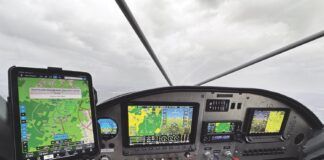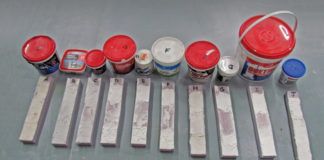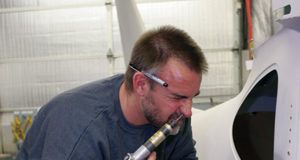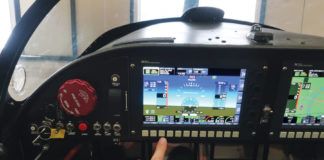Ill admit it right off the crack of the bat: I was one of the physics undergrads taking optics at San Diego State who made the top half of the class possible. I mean, I was a semiconductor physics major. For what did I need optics? And my grade reflected it!
Well, optics is a wonderful window on how microwave antennas work, and dozens of optical phenomena have their exact analogs in this field.
Starting now is a series of columns n the new high-powered LEDs and how they might be used as nav lights. And because the nav light specifications were designed and published in the 1930s, anything that we can come up with for modern devices should beat the specifications by a country mile.
What the FAA Wants
Nav lights were the FAAs first attempt at keeping aircraft separated at night. Otherwise, the forecast is for widely scattered aluminum. Taking our lead from the boating world, we adopted their nav light scheme of red lights on the port side of the vessel (port wine is red, remember ground school?), which leaves green for the starboard wing and white for the light on the tailfeathers. Theory said that you would be able to see another aircraft operating in your general vicinity at night and avoid. That was long before Cirrus and 200-knot patterns.
Also, the FAA wanted us to see certain lights at certain angles and not at others. If I were the “target” aircraft, the FAA would want you to see the white light on my tailfeathers at an angle of at least 70 either side of a direct “hit” on the tail, but not much beyond 90. Similarly, you would need to see my bright wingtip lights from a direct hit on the nose, very little aft of the wing and about 10% either side of a direct hit on the nose. Thus, if you were approaching me from the rear, all you would see is white light. Approaching me head-on, you would see both red and green lights for about 10% either side of a direct nose-on hit. For those of you for whom graphs are easier to understand than words, Ill
illustrate what I believe CFR 14 FAR 23.1391 and 23.1393 are telling us.
As a final data point before we get into the graphs, I chose a new member of the “high-power” LED family from a company called LedEngin, Inc. The devices chosen for this project are 3-watt LEDs with attached thermal conductive pad, part number(s) LZ1-10?103, where the ? is replaced with an R (Red), G (Green) or CW (Cool White), the three colors we need for position lights. The cost? About $9 apiece in onesie-twosies. If you want brighter lights, they have 5- and 10-watt mooses that are painful to look at and even more painful to buy.
The attached thermal pad was extremely interesting, in that most manufacturers connect their thermal pad to one of the diode elements, generally the anode. That makes mounting the device directly to the airframe ground extremely difficult, because with a positive battery supply, the anode is the terminal we have to feed positive current to. With an electrically insulated yet thermally conductive mounting pad, that problem disappears. These little rascals will mount directly to the wingtip flange with plain old 4-40 screws, nuts and bolts.
Light Visibility
Let’s now turn our attention to the graphs provided with this article. Graph 1 shows the vertical lighting minimums, how far above the target aircraft and how far below should we expect to see lights. Obviously, a dead-on hit is the worst situation, so the Feds wanted a minimum of 40 candlepower directly forward of either wing or aft of the tail. The devices we have chosen far exceed this minimum, with the worst being green at 75 candlepower and the best being white at 100 candlepower. When you get above or below 45, there isn’t as much light required, as a direct hit is nearly impossible. However, as the graph shows, even a single LED is well above the FAA minimums.
Graph 2 shows the horizontal lighting minimums for the wingtip lights. Again, the worst possible scenario is a dead-ahead hit, as the sound generated will far exceed most laws regulating noise. Joshing aside, the Feds say that you have to have at least 40 candlepower directly forward, but you cant have too much overlap with the red and green lights at directly forward. With a suitable light baffling mounting plate to control the spillover and reflect this light to the sides, you can pick up that deficiency in the left part of the graph. How? Hey, remember, Im the guy who lights the light. The optics are somebody elses problem. Just remember that polished aluminum is your friend.
Graph 3 shows the horizontal lighting minimums for the taillight. Note that for a single LED, we have way more candlepower than is necessary dead aft, but we don’t have quite enough out at the +/-70 points. Again, a clever optics guy could likely figure out a way to deflect some of that excess boresight light and pass it out to the edges so that we need only a single LED hanging out at the tailfeathers.
Andrew Sarangan did a good article about the nav lights on his Europa. You may wish to take a look at his way of doing things to get an idea of where I am headed. However, he chose to do a very complicated power supply using thermistors, current sensors and heat-producing linear regulators.
Ill show you next month why I think a switching power supply is the way to go and why that is the optimum solution. Until then, you might want to go to Mouser and get a couple of these LEDs to play with. My only suggestion is that you put a light dam between the LED and your face when you first turn the diode on. These suckers are bright.
Stay tuned. We may be able to do the landing light for less than a tenth of the $500 those suckers were going for last year at Oshkosh.













